
Photo 1. Amy Vu portrait. Photo Credit: Randy Fernandez, UF/IFAS Entomology and Nematology
From the University of Florida Honey Bee Research and Extension Laboratory – Part 4
By: Amy Vu
Hi everyone, my name is Amy Vu and I work at the University of Florida’s Institute of Food and Agricultural Sciences Honey Bee Research and Extension Laboratory (UF/IFAS HBREL). Many of you may be familiar with my voice in a podcast called “Two Bees in a Podcast” (if not, now is the time to get your smart phones out and search for it!). This is the first time I have written for Bee Culture and I am excited for the opportunity. I have been with the University of Florida since 2016, beginning my career as a county Extension agent in Orange County (Orlando and the surrounding area). Since then, I transitioned to the HBREL in 2019 and the rest is history. My current title at UF/IFAS is “State Specialized Program Extension Agent, Apiculture”, and I somehow still fumble over the words in my title anytime I introduce myself. To sum up what I do: my work involves working with beekeepers and their stakeholders, identifying needs, conducting activities and evaluating programs. I will elaborate more throughout this article. If you have been following the past few months of this series, you have learned that there are three key components to a Land Grant Institution (LGU) (Instruction, Research and Extension). Jamie discussed the overview of LGUs and research. Cameron discussed formal instruction program. In this article, I have the honor of writing about the third leg of the stool (and my personal favorite) to bring it all together, Extension! As Jamie mentioned, all universities engage in teaching degree-seeking student and research, but not all universities provide one of the LGUs critical missions, Extension. One thing you will notice throughout the article is that Extension cannot happen without connections and collaborations with our stakeholders and that feedback is extremely important. I am here to share the good, the bad and the ugly. Next month, our program coordinator, Louis, will be sharing with you about the Extension workshops we conduct at our lab.
Before I continue further, I would like to share a bit about myself. I was born and raised in Overland Park, Kansas (Go Chiefs!), a city kid with no agriculture exposure. It was not until a study abroad program in Ecuador in 2009 that my attention turned to agriculture and where our food originates. I immediately fell in love with understanding our world’s food systems and completed my bachelor’s degree at Kansas State University in Agronomy with an emphasis on Soils and Environmental Science. From there, I moved to Blacksburg, Virginia, where I worked on a Master’s degree in Agricultural Leadership and Community Education at Virginia Tech. In 2014, a group of colleagues in graduate school and I decided that we wanted to try a new endeavor: beekeeping, because… why not? It seemed like a fun new challenge. Little did I know, that experience would change the course of my entire career. After graduation, I decided to move to Florida, since I am a scuba cave diver and wanted to be closer to the freshwater springs (did you know that Florida has one of the largest concentrations of freshwater springs in the world?). The springs brought me to Florida, but the bees have kept me here. During my time working in Orange County, I attended the local Orange Blossom Beekeepers Association (OBBA) monthly meetings. After a few meetings, I started to realize that the association was spending ¾ of the meeting time answering basic honey bee terminology and having to take a step back each month to teach newbies equipment terminology. They were losing more advanced beekeepers, and I wanted to help, and knew that I could with my Extension programs. The association and I started working together, which resulted in a beginner beekeeping series. The association helped me promote it and we timed it perfectly, so my programs would be held the Tuesday following monthly meetings. This helped reduce the beginner beekeeping time at the monthly meetings and allowed the association to focus on more advanced topics.
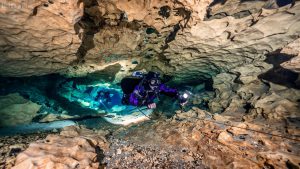
Photo 2. Amy cave diving in Madison Blue Spring State Park. Photo credit: Lauren Wilson
What is Extension and an Extension Agent anyway?
Something I hear often is “So… is your job to run the UF honey bee lab’s social media page?” This is something I have heard before, and the answer is “yes, kind of, but also… no, I do so much more than that.” Social media is only one method of communication for how we connect with stakeholders and market our programs. Just to recap and quote Jamie’s first article: “Faculty at LGUs engage in formal education (teaching students) and informal education (teaching everyone else). The latter is called Extension.” Let’s start with the basics. We define an “agent” as a person who acts on behalf of another person or group. In Extension, my job is to bridge the gap between industry, researchers, government agencies and more by providing non-formal education and learning activities to all types of individuals. In short, we are a resource for our stakeholders. Extension originated to help mostly with rural areas but has evolved to work with both rural and urban areas. We are messengers and disseminate science to our stakeholders.
It is always extremely difficult for me to explain to people what my job is and how it relates to UF/IFAS, but in a nutshell, my job is to share research and do my best to stay up to date with new and emerging topics. In Extension, there are many programmatic areas. The most common programs and topics that are well known are Horticulture, Agriculture and Natural Resources (ANR), 4-H, Family and Consumer Services (FCS) agents.
The History of Extension
The Smith Lever Act formalized Extension in 1914. At the time, Extension services were provided exclusively to rural agricultural issues. Over 50% of the U.S. lived in rural areas, and 30% of the workforce was engaged in farming. Because of Extension, farmers increased their productivity, allowing farmers to make better management decisions. This resulted in a higher production of food. Basically, there was research being conducted at the university, but the practical research was not being shared with farmers. Extension agents were hired to bridge the gap, hold workshops to help growers, and act on behalf of growers to let researchers know what practical research could be conducted to help the industry. Extension has changed immensely in the last century. Today, less than 2% of Americans farm for a living, and only 17% live in rural areas. That said, Extension specialists must be creative with their programs, increasing their audience size by diversifying their workshops, activities and communication. Programs in urban areas have increased and the specialties have expanded beyond farming and canning classes. In the United States, Extension/Ag offices are located in over 3,000 counties.
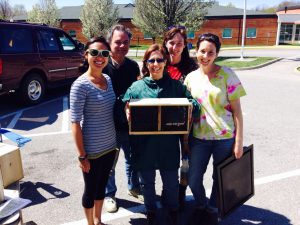
Photo 3. Picking up our first packages in 2014. Pictured here: Amy Vu, Rachel Kennedy, Sarah Halvorson-Fried and Becca Ligrani
What is an Extension Program and How are They Conducted?
Extension is a federal, state and county partnership. The purpose of Extension is to bring the most recent and cutting-edge research from laboratories to those who can use the information to learn and implement skills into practice. This is done through Extension programs. There is a theory to what we do as Extension agents and how we develop programs. Developing a program requires planning, implementing, evaluating and doing that over and over (and over) again. Agents will identify an overarching theme (for example, collaborating with beekeepers to increase honey bee colony health), and then plan workshops or create materials that fall in line with the overarching theme (for example, holding a hands-on honey bee workshop focusing on honey bee stressors, like Varroa management). These themes are called “Programs” (with a big P!), which is contrary to what people may think a “program” is. Most individuals hear of the word “program” and think of a workshop or one hour talk on honey bees. In Extension, when we hear the word “Program”, we think about the big picture theme of what we are trying to accomplish. To develop, implement and evaluate our programs, we use something called a Logic Model (and I know that as soon as I mentioned the words “logic model”, I hear every Extension Agent’s eye roll and grunt from here). All joking and sarcasm aside, a Logic Model is an extremely helpful tool that agents use to plan an Extension program. It is a blueprint and vision for our programs to help us focus on the bigger picture.
Using a Logic Model
It always starts with a needs assessment and identifying the situation
Conducting a needs assessment is the foundation of a good Extension program. Understanding the needs of a community is crucial to know how to move forward and how to disseminate information. Understanding your audience helps with being successful. This can be done by simply asking questions and listening. Extension is all about the relationships we build with our stakeholders. Without the collaboration, a successful program cannot exist. As apiary educators, we are constantly on the search to hear what is happening in the field. Are we hearing about high colony losses? Why do beekeepers believe they are losing colonies? What time of year is it? Has this happened before? Are we concerned about a new invasive pest or disease?
Let’s look at a situational example specific to Florida. This example can be scaled up to be used all over the world: There are over 5,000 registered beekeepers managing approximately 700,000 colonies in Florida. Of these 5,000 beekeepers, hobby (zero to 40 colonies) and sideline (41-99 colonies) beekeepers make up ~92% of all beekeepers, while the rest (~8%) are commercial beekeepers (100+ colonies) (Florida Department of Agriculture and Consumer Services – Division of Plant Industry (FDACS DPI), personal communication). Beekeepers report an annual loss of 40% colony decline. The reasons identified for the losses are Varroa, nutrition, queen quality and pesticides. Thus, Extension programming focused on how to monitor, manage and control honey bee stressors is necessary to minimize colony losses.
In this scenario, here are the Programs (overarching themes):
- Honey bee health: best management practices are needed related to Varroa, nutrition, queen quality, minimizing pesticide exposures, etc.
- Training the trainers: The need is to work with UF/IFAS Extension Agents, apiary inspectors and other Extension educators to extend this content.
How do we acknowledge the situation?
Target Audience
First, we must consider who the program is targeting. Who will show up and in what ways will they show up? Is an e-mail listserv better than an in-person workshop? What good is a program if you hold a workshop and no one attends? Typically, our target audiences are beekeepers: backyard, sideline and commercial. But it is important to recognize that not all beekeeper’s needs are the same. Other audiences’ agents work with and include non-beekeepers to teach them about the importance of honey bees to our agriculture.
After identifying needs and our audience, we must analyze the needs and turn them into objectives. It is typical for us to have two to three objectives per Program. We use SMART objectives to hold ourselves accountable. So what does SMART as an acronym mean?
Specific: Who is the audience and what is the goal? Are we addressing a specific action or is it too complex or broad?
Measurable: The results should be quantifiable—the goal will have a target timeline or benchmarks designed to measure progress. How will we know when the objective has been accomplished?
Attainable: Is it realistic? Are there clear steps to adopt any recommendations?
Relevant: Does the objective align with the mission and vision of the organization?
Time-bound: It must have a beginning and pre-determined end. Also, there should be timed milestones at which progress can be evaluated along the way. Developing a timeline helps one evaluate performance and efforts on a regular basis.
So here is a SMART objective that I will continue to refer to throughout the article:
“At least 75% of individuals who participate in the UF/IFAS HBREL’s events will begin monitoring for Varroa using an alcohol wash or sugar shake within six months of attending a program. This will be measured by post program evaluations and follow-up surveys.”
Okay, so now that we have an objective, let’s talk about the fun part – the activities!
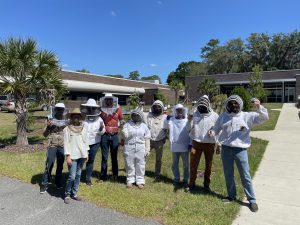
Photo 4. A group of UF/IFAS Extension Agents in an in-service training learning about Varroa monitoring using the alcohol wash method.
Educational Methods and Activities
Inputs – what we invest
Extension’s job is to translate science-based research into digestible bits—whether that be written, verbal, in person or virtual. What money, facilities, technology, people and other resources are needed? What is the time commitment? What materials do we need to conduct a workshop? Can we conduct a Varroa monitoring class without the proper equipment? Do we have the appropriate classroom space or apiary space to conduct the program? What personnel (staff, volunteers, etc.) are needed to implement the workshops? Do we need supplementary materials to support our activities (like PowerPoint presentation, fact sheets, a brochure, etc.)? What about technology? When COVID began, we had to be creative and start using Zoom. Our inputs changed and we needed access to Zoom and other programs to implement our trainings. Knowing what inputs are necessary are important to think about to ensure the success of the program.
Outputs
Activities – what we do
The most common activities for apiculture educators are in-person workshops in a classroom or out in the apiary. Sometimes we are invited speakers at beekeeping association meetings. Sometimes we plan and hold workshops in person or a talk on Zoom. This is the piece of Extension that is the most visible. The activities we conduct are completely dependent on our target audience. For example, sometimes it is easier for hobbyist beekeepers to attend an evening or weekend event, so we will hold larger classes on hobbyist topics during that time. Other times, commercial beekeepers may be working and unavailable, so it may be easiest to conduct a single site visit to their operation. Another activity that is extremely common is answering beekeeping related questions from our stakeholders, whether that be over the phone, e-mail or a message on social media. It is important that we are available as a resource.
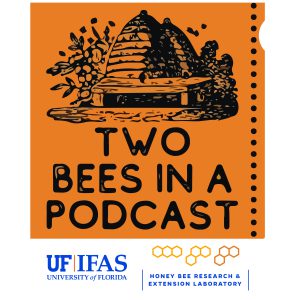
Photo 5. Two Bees in a Podcast logo
Here at the University of Florida, we have key activities with which you may be familiar. Our Extension Coordinator, Louis will elaborate on these activities in next month’s article: the UF/IFAS Master Beekeeper Program, BeeLearning Short Courses, UF/IFAS Bee Colleges, Two Bees in a Podcast and the UF/IFAS Honey Judge Program. Additionally, the UF/IFAS honey bee team regularly provides lectures and workshops at various training events.
Outcomes
What do we want to see accomplished in the short, medium and long term from our programs? How do we identify these outcomes? Let’s revisit our example objective mentioned earlier: At least 75% of individuals who participate in the UF/IFAS HBREL’s events will begin monitoring for Varroa using an alcohol wash or sugar shake within six months of attending a program. This will be measured by post program evaluations and follow-up surveys.
Short term outcomes focus on gaining knowledge, raising awareness, creating a positive attitude, developing a skill/opinion or increasing motivation. From our example, a short-term outcome could be that participants increase their knowledge about Varroa monitoring and learn how to collect a sample using an alcohol wash. Developing this skill has increased their motivation and attitude to conduct samples more frequently.
Medium term outcomes focus on seeing a behavior or practice in motion. From our example, a medium-term outcome could be that six months after the training, beekeepers have started monitoring for Varroa monthly using an alcohol wash and make informed decisions on whether to treat for Varroa or not, based on thresholds.
Long term outcomes are the ultimate impact. These are usually social, economic or environmental. When making informed decisions related to Varroa management, long term outcomes involve minimizing overall colony losses, which can increase production, and in turn increase profitability.
How do we know our programs are effective?
I will not bore you with the 30-page report we have to submit annually, but I will describe some ways we report our programs. After conducting a needs assessment, coming up with objectives and holding an activity/workshop, we must show that our programs have made a difference. For formal Instruction, students take exams, write papers and end the semester with a grade. Researchers are evaluated by the number of grants they bring in and how many peer-reviewed publications are accepted each year. For Extension, we must show that we are changing lives for the better… CHANGING LIVES! Easy to measure, right? Our big question is: “so you’ve put all this work into a program… SO WHAT?” That’s probably a bit harsher than reality, but you get the gist. If you have taken part in an Extension activity, you have likely taken a pre- and post-test, filled out a survey immediately after a program and have been asked to fill out a follow-up end of year survey. We also use general feedback, verbal and written, in consideration for our evaluation. Evaluation is the most critical component of Extension. It determines whether we move our programs forward (or not). I cannot stress the importance of evaluation enough. In short, we must show that our Extension efforts are making a positive difference, and if they are not, maybe it is time to rethink how we conduct our programs.
International Extension Activity Highlight
Our Extension efforts extend well beyond our county, state and country. I would like to highlight one international activity in which I participated and maybe you can identify some of the pieces of the logic model I mentioned earlier. I was fortunate to be involved in the United States Agency for International Development (USAID)’s, Partners of the Americas, Farmer-to-Farmer program in February 2023. As a volunteer in the Dominican Republic, I was joined by a Florida commercial beekeeper, Chris, and his wife Melissa Vasquez, with Heritage Bee Farm, LLC. We had the most wonderful field officers, Maria Montas and Francisco Mendez, who helped translate technical honey bee content in Spanish. We worked with ASAJA (their beekeeper association) in the beautiful Jarabacoa mountains for 15 days. The beekeepers were all in their first five years of beekeeping. Many of them were beginner beekeepers, while a few members of the association were not. Those few aspired to become full time beekeepers and wanted to learn more about general management and queen production. It was a huge breath of fresh air (I did not know what to expect) to see that the honey bees were strong and had all the pollen and nectar available to them (the beekeepers do not need to feed there, since there is so much pollen and nectar flow). The beekeepers also do not have small hive beetles present on the island (lucky them!). During our initial meeting, Chris and I learned that the beekeepers were interested in learning more about pest and disease management, equipment management and queen production. We saw Varroa on the bees, thus prompting me to ask the beekeepers what they used (and how often) for treatment. They use thymol and oxalic acid-based products. Prior to our visit, beekeepers were only monitoring and treating once a year. In our program, we spent every day conducting a needs assessment and evaluating colonies, implementing short hands-on workshops and providing recommendations on when to graft larvae for queen production. We also piloted the use of coconut water as a media for queen production and discussed how often to monitor for Varroa, when to treat and the importance of rotating active ingredients. At the end of the two weeks, we provided resources for the beekeepers to help continue with their education. On the last day, Chris and I delivered a presentation about what we learned, what we observed, and provided recommendations (using SMART objectives) to the association on how they could be successful as a team in the long term. I evaluated the program by interviewing 10 program participants, asking about potential challenges, what they learned and what other resources or training they still need to be successful as a beekeeper. I hope to spend the next few months evaluating the data. I am fully convinced that our short time in the Dominican Republic will have long term outcomes for the beekeepers and it was an extremely rewarding Extension experience.
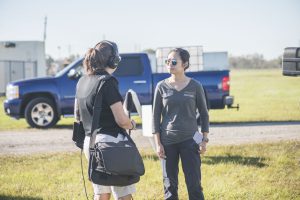
Photo 6. Amy speaking to media to discuss the importance of honey bees and commercial beekeepers to agriculture after Hurricane Ian left devastating losses to Florida beekeepers in 2022. Photo Credit: Bori Bennett
What else do Extension agents do?
Okay, so back to Apiary Extension! We discussed needs assessments, developing programs, conducting site visits, speaking engagements to beekeeper associations, responding to phone calls and e-mails, creating content to support our programs and program evaluations. What else do agents do? You will find us at group meetings, speaking at professional conferences, writing and receiving grants, and being involved in other committees at our university and state associations. It may seem like we are everywhere, and that is because we are! Having the ability to be everywhere can be great, but it is all about balance.
Challenges of being in Extension
Not everything in Extension is a rainbow or unicorn. Being in Extension is the most rewarding career (in my humble opinion), but there are some struggles that many agents face. First, it is a blessing and a curse to have the ability of being creative with a program, which usually results in wanting to help and say “yes” to everything. There are so many potential projects, and simply not enough time to do them all. Focusing on long term projects when smaller “fires” arise and having to prioritize projects is crucial. When you speak to an Extension agent who has been successful in their career, the first thing they will tell you is to “focus on the big picture and learn how to say no.” Taking on every single project often results in major burnout and it can be very detrimental to our programs. Agents will feel like they are doing so much daily, but at the same time, not doing anything at all. This is something that is often seen, and the reason agents will leave their positions and transition to something else.
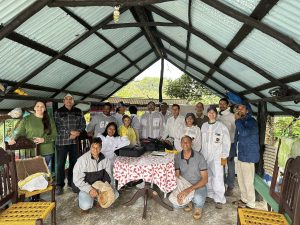
Photo 7. ASAJA Beekeepers Association in Jarabacoa, Dominican Republic. The participants were part of the USAID, Partners of the
Americas, Farmer-to-Farmer Program.
Second, agents are required to wear many hats. We are the event planner, marketing specialist, evaluation guru and content specialist. We must stay up to date with the times (whether that is jumping onto a new social media platform, creating content that is user friendly, etc.). We need to know how to design and use multi-media, be an expert in video, photo, or podcast production. We have administrative paperwork, we are expected to submit publications, speak at conferences and respond to thousands of e-mails and phone calls, and media requests at any moment.
Lastly, working with many types of personalities and people can be great, but also challenging. Anyone working with people has likely encountered a conflict before and knowing when and how to handle a conflict is crucial. It is important to remember that needs and priorities can differ from person to person. Facilitating conversations and relationships is important to get everyone on the same page to identify one common goal.
“The Good”
Despite some of the challenges an agent can face, I personally feel like I have the best job in the world. I will end this article with the positives of being in Extension. Extension agents have the privilege of working with people who become our family and friends. Many times, it becomes more than just a job, and it becomes the genuine connections we make with our stakeholders. I get to know personalities on an individual level. I meet their families, friends, pets, learn about their other hobbies, and so much more. I have watched beekeepers’ children grow up before my eyes. I have seen beekeepers progress from 50 colonies, to 100, and then to thousands of colonies. I consider beekeeper successes my successes.
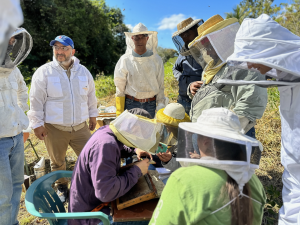
Photo 8. Yancarlos Castillo grafting larvae to learn about honey bee queen production in Jarabacoa, Dominican Republic as part of a USAID, Partners of the Americas, Farmer-to-Farmer Program.
Second, I have seen groups of beekeepers work together to make a huge difference for the industry. Just one example is the building of our UF/IFAS HBREL facility. The $4.5 million facility came from the collaborative efforts of the Florida State Beekeepers Association, the Florida Department of Agriculture and Consumer Services, Florida beekeepers and other stakeholders. To watch a simple idea turn into a reality is incredible to see. “Never doubt that a small group of thoughtful, committed citizens can change the world; indeed, it’s the only thing that ever has.” —Margaret Mead.
Lastly, as Extension agents, we are fortunate to have the opportunity to be flexible with our programs and try new ideas. Extension agents will never have the same day at work. Some days are in the office, some days are in the field and others are presenting to local, state and national associations. We travel around the world to conferences or workshops meeting beekeepers and other individuals in the beekeeping industry, from regulatory/government personnel, non-profit organizations, researchers and other apiculture Extension specialists around the world. We are fortunate to network and work with the various stakeholders who play a piece in this large puzzle. The beekeeping community is so small and knowing what part everyone plays makes a huge difference.
In conclusion, being in Extension is not just a job, but a lifestyle. I love working in Extension and with beekeepers around the world. I enjoy connecting with beekeepers, hearing what is going on in their apiaries and being involved with the industry. I feel like I am making an immediate difference in the lives of beekeepers of all operations and hope to continue to serve beekeepers well into the future. Next month, our extension coordinator, Louis Dennin, will highlight specific activities we do at our lab. Thank you beekeepers, for all the great work you do, and allowing me to be part of the beekeeping community.








